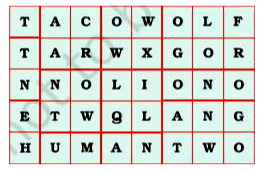Give one example each of herbivore, carnivore and omnivore.
Rabbits are herbivores, tigers are carnivores and human beings are omnivores
Topper's Solved these Questions
- OUR ENVIRONMENT BOOK - BHARATI BHAWAN (ENGLISH)CHAPTER - OUR ENVIRONMENT EXERCISE - Short-Answer Question
13 Videos
- OUR ENVIRONMENT BOOK - BHARATI BHAWAN (ENGLISH)CHAPTER - OUR ENVIRONMENT EXERCISE - Long Answer Questions
9 Videos
- OUR ENVIRONMENT BOOK - BHARATI BHAWAN (ENGLISH)CHAPTER - OUR ENVIRONMENT EXERCISE - Fill in the blanks.
6 Videos
- NUTRITION BOOK - BHARATI BHAWAN (ENGLISH)CHAPTER - NUTRITION EXERCISE - True (T) or false (F)
10 Videos
- PRACTICALS BOOK - BHARATI BHAWAN (ENGLISH)CHAPTER - PRACTICALS EXERCISE - MCQs
177 Videos
Similar Questions
Give two examples of herbivores.
View SolutionIdentify the animals in the grid given below as Fig. 1.1 and categorise them into herbivore, carnivore and omnivore.

View SolutionGive examples of five herbivores.
View SolutionGive one example of each of these nutrition.
View SolutionGive one example each of sol and gel.
View SolutionGive one example each of positive and negative sol.
View SolutionGive one example each of a macronutrient and micronutrient.
View SolutionOrganisms depend on the producers either directly or indirectly for their sustenance ? These organisms which consume the food produced, either directly from producers or indirectly by feeding on other consumers are the consumers. Consumers can be classed variously as herbivores, carnivores, omnivores and parasites.
The microorganisms, comprising bacteria and fungi, break-down the dead remains and waste products of organisms. These microorganisms are the decomposers as they break-down the complex organic substances into simple inorganic substances that go into the soil and are used up once more by the plants.
Give one example each of a herbivore, carnivore, omnivore and a parasite.
View SolutionGive one example of each type of dopants.
View SolutionGive one example each of a reversible and a irreversible reaction.
View Solution
